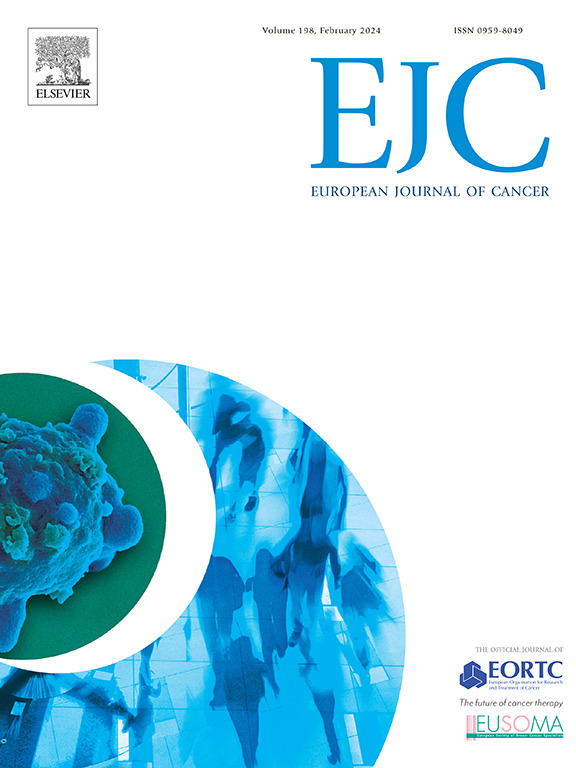Antibody drug conjugate targets are highly differentially expressed across the major types of ovarian cancer
IF 7.6
1区 医学
Q1 ONCOLOGY
引用次数: 0
Abstract
Background
Antibody-drug conjugates (ADCs) are emerging anti-cancer agents. The folate receptor alpha (FOLRα)-directed ADC mirvetuximab soravtansine recently demonstrated clinical activity in platinum-resistant ovarian cancer, with other ADCs currently in development. The relative expression of FOLRα and other ADC targets is largely unknown across ovarian cancer histotypes.
Methods
Expression levels of the ADC targets FOLRα, TROP2 and B7-H4 were assessed by immunohistochemistry in patient cohorts using tumour tissue microarrays of the major ovarian cancer histotypes: high grade serous (HGSOC, n = 331); endometrioid (EnOC, n = 101) and clear cell ovarian carcinoma (CCOC, n = 60). Degree of expression was quantified by membrane histoscore.
Results
We observed differences in ADC target expression patterns across ovarian cancer histotypes. FOLRα expression was highest in HGSOC, with few EnOC or CCOC demonstrating positivity (HGSOC: 70.9 % FOLRα histoscore ≥50 vs 21.1 % and 29.3 % in EnOC and CCOC). B7-H4 was expressed in HGSOC, EnOC and CCOC (99.7 %, 89.8 % and 80.7 % with histoscore ≥50). CCOC were mostly TROP2 negative (89.3 % with histoscore <50); a subset of HGSOC and EnOC expressed TROP2 (54.8 % and 57.7 % with histoscore ≥50, respectively). There was no significant association between ADC target expression and molecular subtypes of HGSOC (BRCA1/2-mutant, CCNE1-gained, other) or EnOC (TP53-mutant, CTNNB1-mutant, POLE-mutant, MMR deficient, no specific molecular profile). In CCOC, ARID1A/B mutation was associated with lower B7-H4 expression (P-adj=0.024).
Conclusion
EnOC and CCOC are usually FOLRα negative, while HGSOC, EnOC and CCOC frequently express B7-H4. TROP2 positivity is limited to HGSOC and EnOC. Careful consideration of histotype and ADC target expression levels is warranted when designing and analysing clinical studies of ADCs.
抗体药物偶联靶点在主要类型的卵巢癌中表达高度差异
抗体-药物偶联物(adc)是新兴的抗癌药物。叶酸受体α (FOLRα)导向ADC mirvetuximab soravtansine最近在铂耐药卵巢癌中显示出临床活性,其他ADC目前正在开发中。在卵巢癌组织型中,FOLRα和其他ADC靶点的相对表达在很大程度上是未知的。方法采用肿瘤组织微阵列技术,采用免疫组化技术检测ADC靶点FOLRα、TROP2和B7-H4在主要卵巢癌组织类型患者中的表达水平:高级别浆液性(HGSOC, n = 331);子宫内膜样癌(EnOC, n = 101)和透明细胞卵巢癌(CCOC, n = 60)。通过膜组织评分定量表达程度。结果我们观察到ADC靶表达模式在卵巢癌组织类型中的差异。FOLRα在HGSOC中表达最高,很少有EnOC或CCOC表现出阳性(HGSOC: 70.9 % FOLRα histoscore≥50 vs EnOC和CCOC分别为21.1 %和29.3 %)。B7-H4在HGSOC、EnOC和CCOC中表达(99.7 %、89.8 %和80.7 %,histoscore≥50)。CCOC多为TROP2阴性(89.3% %,histoscore <50);HGSOC和EnOC的一部分表达TROP2(分别为54.8% %和57.7% %,histoscore≥50)。ADC靶蛋白表达与HGSOC (brca1 /2突变型、ccne1获得型、其他)或EnOC (tp53突变型、ctnnb1突变型、pole突变型、MMR缺陷型、无特异性分子谱)的分子亚型之间无显著相关性。在CCOC中,ARID1A/B突变与B7-H4低表达相关(P-adj=0.024)。结论EnOC和CCOC多为FOLRα阴性,而HGSOC、EnOC和CCOC多表达B7-H4。TROP2阳性仅限于HGSOC和EnOC。在设计和分析ADC的临床研究时,需要仔细考虑ADC的组织型和靶表达水平。
本文章由计算机程序翻译,如有差异,请以英文原文为准。
求助全文
约1分钟内获得全文
求助全文
来源期刊

European Journal of Cancer
医学-肿瘤学
CiteScore
11.50
自引率
4.80%
发文量
953
审稿时长
23 days
期刊介绍:
The European Journal of Cancer (EJC) serves as a comprehensive platform integrating preclinical, digital, translational, and clinical research across the spectrum of cancer. From epidemiology, carcinogenesis, and biology to groundbreaking innovations in cancer treatment and patient care, the journal covers a wide array of topics. We publish original research, reviews, previews, editorial comments, and correspondence, fostering dialogue and advancement in the fight against cancer. Join us in our mission to drive progress and improve outcomes in cancer research and patient care.
 求助内容:
求助内容: 应助结果提醒方式:
应助结果提醒方式:


